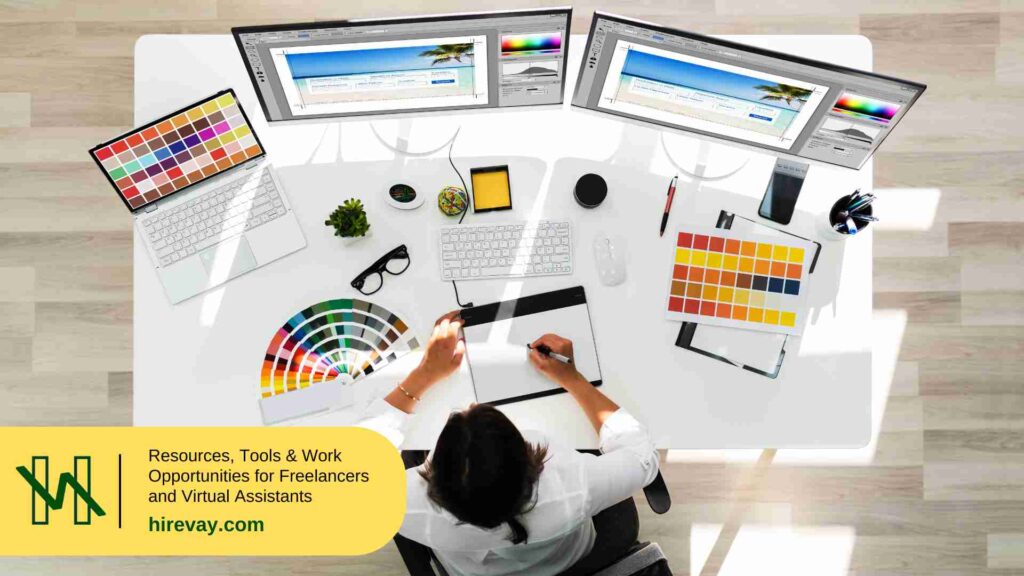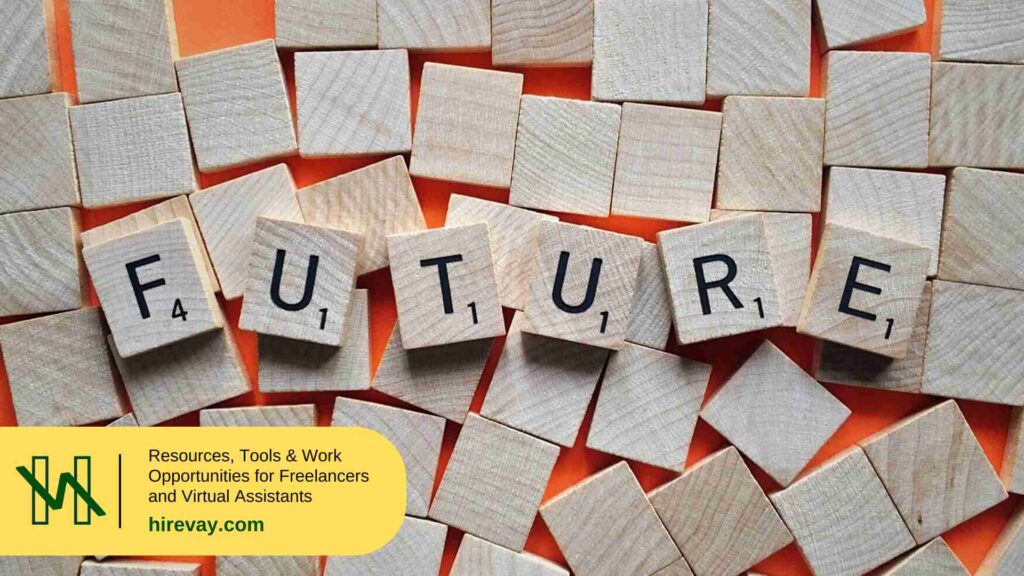Table of Contents

Understanding Virtual Assistant Graphic Design Services
Have you ever wondered how virtual assistant graphic design services can revolutionize your visual content strategy? Let’s dive into the fascinating world of virtual assistance and uncover how it caters to your graphic design needs.
Definition and Scope of Virtual Assistant Graphic Design Services
Virtual assistant graphic design services encompass a broad range of tasks related to visual content creation, carried out remotely by skilled professionals. These services include everything from creating social media posts and marketing materials to designing comprehensive brand identities. The role of a virtual graphic designer is to support businesses and individuals by interpreting their visual communication needs and translating them into engaging, effective designs.
Virtual assistants bring immense flexibility to the table, accommodating various design requests regardless of their complexity. Whether you need a simple logo or a multifaceted website overhaul, virtual assistants are equipped to handle the job with a high level of expertise.
Benefits of Choosing Virtual Assistants for Graphic Design
Opting for virtual assistants for your graphic design projects can be a game-changer for your business. Here are some key benefits:
- Cost-effectiveness: Hiring a virtual assistant can be significantly more affordable than engaging a traditional design agency. Virtual assistants often operate with lower overhead costs since they work remotely, which translates to more competitive pricing for clients.
- Flexibility: Virtual assistants offer unparalleled flexibility in terms of availability and scheduling. They can adapt to your varying project timelines and immediate design needs, making them invaluable for businesses with fluctuating workloads.
- Diverse Talent Pool: By choosing virtual assistants, you gain access to a global network of talent. This diversity brings a wealth of creative perspectives and innovative ideas to your projects, ensuring that your designs stand out in a crowded marketplace.
- Scalability: As your business grows, so do your design needs. Virtual assistants can scale their services to match your expanding requirements, providing the support you need without the hassle of long-term commitments.
Types of Projects Virtual Assistants Can Handle
Virtual assistants are versatile and capable of managing a wide array of graphic design projects. Here’s a glimpse into some of the common types of projects they can masterfully handle:
- Social Media Graphics: Creating eye-catching graphics for platforms like Instagram, Facebook, and Twitter to enhance your social media presence and engagement.
- Marketing Materials: Designing brochures, flyers, posters, and email templates that align with your brand’s marketing strategies and goals.
- Branding and Logo Design: Developing unique brand identities, including logo design, color schemes, typography, and brand guidelines to create a cohesive visual representation of your business.
- Website and Digital Assets: Crafting website designs, user interfaces, banners, and other digital assets that elevate your online presence and user experience.
- Presentations: Designing professional and visually appealing presentations that capture your audience’s attention and convey your message effectively.
By leveraging the skills of virtual assistants, you can ensure your graphic design projects are executed with precision, creativity, and a keen eye for detail. Their expertise not only enhances your visual content but also empowers your brand to achieve new heights.
Next, let’s explore the key advantages that make virtual graphic design solutions stand out in today’s competitive market.

Key Advantages of Virtual Graphic Design Solutions
Cost-effectiveness Compared to Traditional Design Agencies
One of the primary reasons businesses are turning to virtual graphic design solutions is the significant cost savings. Traditional design agencies come with high overheads such as office space, equipment, and large teams, all of which contribute to the higher fees charged to clients. Virtual assistants (VAs), on the other hand, operate remotely. This setup eliminates many of the traditional overhead costs, which translates to more affordable rates for businesses.
When you leverage a virtual assistant for your graphic design needs, you typically pay for the actual work done rather than additional operational costs. This model is particularly beneficial for startups and small businesses that need to manage their budgets carefully while still availing high-quality design services.
Flexibility and Scalability of Virtual Design Services
Virtual design services offer unparalleled flexibility and scalability. Traditional agencies often work on a fixed schedule, with deadlines that may be rigid. Conversely, virtual assistants provide a flexibility that can accommodate varied client needs. Whether you require design services on an ad-hoc basis, for a short-term project, or for ongoing support, virtual assistants can usually adapt to your time frame and workload.
Scalability is another advantage of virtual design services. As your business grows, your design needs will evolve. A virtual assistant can quickly scale their services to match your demand, whether you need additional marketing materials for a new product launch or a complete website redesign. This scalability ensures that you are never paying for more than what you need at any given time, making it a cost-effective and resource-efficient solution.
Access to Diverse Global Talent and Creative Perspectives
One of the most compelling benefits of opting for virtual graphic design solutions is the access to a diverse pool of global talent. Traditional agencies might have a limited number of designers, which can restrict the range of creative perspectives you receive. Virtual assistants can be sourced from anywhere in the world, bringing a wealth of diverse experiences, cultural insights, and unique design styles to your projects.
This international talent pool means you can tap into creative perspectives that you might not find locally. Different regions bring different artistic influences, which can add a fresh, innovative touch to your visual content. Additionally, working with a variety of designers allows you to find the perfect fit for your brand’s aesthetic and voice.
Selecting a virtual assistant for graphic design can transform your visual strategy. Not only do you gain flexibility and scalability, but you also benefit from cost savings and access to a rich tapestry of creative talents from around the globe. As we move forward, it will be important to explore how these services can be seamlessly integrated into your business operations to maintain consistency and efficiency.

Essential Design Services Offered
Social Media Graphics and Marketing Materials
Have you ever wondered how brands create captivating social media posts that trip off the scroll and engage audiences? Virtual assistants are redefining this space with their expertise in designing high-impact social media graphics. These professionals can craft eye-catching images that align with current trends while maintaining your brand’s identity across various platforms like Facebook, Instagram, Twitter, and Linkedln.
Moreover, virtual assistants can develop a suite of marketing materials designed to enhance your online presence and drive engagement. Whether it’s promotional banners, email newsletter templates, or infographics, virtual assistants bring a blend of creativity and strategic thinking to each project. By leveraging their skills, your brand can create visually appealing content that not only attracts attention but also communicates your key messages effectively.
Branding and Logo Design Capabilities
Your brand speaks volumes, often before a single word is read. Virtual assistants who specialize in branding and logo design understand the importance of creating a strong visual identity that resonates with your target audience. They can develop unique logos, color schemes, typography, and other brand elements that set your business apart from competitors.
These virtual designers work closely with you to ensure that the final product embodies your brand’s ethos and appeals to your intended market. By entrusting your branding and logo design to virtual assistants, you gain access to their global perspectives and creative insights, enabling the creation of a cohesive and compelling brand image.
Website and Digital Asset Creation
Choosing the right visuals for your website can be a game-changer. Virtual assistants proficient in web design and digital asset creation can transform your site into a compelling, user-friendly experience. They specialize in designing everything from banners and icons to complete web layouts that are both aesthetically pleasing and functional.
By leveraging the services of virtual designers, your website can reflect your brand’s personality while providing an intuitive navigation experience for users. These professionals understand the nuances of digital design, ensuring that every element from loading speed to mobile responsiveness is optimized to enhance user engagement and satisfaction.
From managing e-commerce platforms to creating visually appealing landing pages, the range of digital asset creation by virtual assistants ensures that your online presence remains dynamic and engaging. This is crucial for businesses looking to stand out in a crowded digital landscape, ensuring your site not only attracts visitors but also retains them.
By exploring the full spectrum of design services virtual assistants offer, you empower your brand with creative, cost-effective, and scalable solutions. This strategic approach not only elevates your visual content but also significantly contributes to your overall business growth.
Now, as we continue to delve into the intricacies of virtual graphic design services, let’s consider the collaborative strategies that make these partnerships so effective.

Collaboration and Communication Strategies
As we delve into the heart of how virtual assistant (VA) graphic design services can seamlessly integrate into your workflow, it is essential to grasp the collaboration and communication strategies that ensure successful project outcomes. This chapter will empower you with effective brief writing and project management techniques, tools and platforms for seamless collaboration, and strategies for maintaining brand consistency across projects.
Effective Brief Writing and Project Management Techniques
Delivering a clear and comprehensive brief to your virtual assistant is the cornerstone of successful projects. A well-crafted brief sets clear expectations, streamlines the creative process, and minimizes misunderstandings. So, what makes a brief effective?
- Define Objectives and Outcomes: Clearly state the purpose of the project and the desired outcomes. For example, “Increase social media engagement by creating visually appealing Instagram posts.”
- Provide Detailed Descriptions: Include specifics about the project, such as colors, fonts, layouts, and any other design elements you envision. Attach references or inspiration to clarify your vision.
- Establish Timelines: Set realistic deadlines and milestones to ensure the project progresses smoothly. This helps both you and your virtual assistant stay on track.
- Clarify Budget Constraints: If there are any budget limitations, mention them upfront to avoid any surprises later on.
Project management, on the other hand, involves overseeing the project from start to finish, ensuring deadlines are met and objectives are achieved. Effective project management techniques include:
- Regular Check-ins: Schedule frequent updates to monitor progress and provide feedback.
- Use of Project Management Tools: Platforms like Trello, Asana, or Basecamp can help organize tasks, track timelines, and facilitate communication.
By combining a detailed brief with robust project management, you set the foundation for a productive partnership.
Tools and Platforms for Seamless Collaboration
The rise of virtual collaboration tools has revolutionized remote work, making it easier to manage and complete projects with virtual assistants. Here are some tools that can facilitate seamless collaboration:
- Communication Platforms: Slack and Microsoft Teams offer real-time messaging, video calls, and file sharing, making communication fast and efficient.
- Design Collaboration Tools: Platforms like Figma and Adobe Creative Cloud enable real-time sharing and editing of designs, allowing for instant feedback and collaboration.
- File Sharing Services: Google Drive and Dropbox are excellent for sharing resources, storing files, and collaborating on documents.
Utilizing these tools can streamline your workflow, enhance communication, and ensure everyone is on the same page.
Maintaining Brand Consistency Across Projects
Consistency is key in building a recognizable brand. When working with virtual assistants, it’s crucial to maintain a cohesive visual identity across all projects. Here are some strategies to ensure brand consistency:
- Create a Brand Style Guide: A comprehensive style guide outlines your brand’s visual and tonal elements, including logos, color palettes, typography, and imagery guidelines. Providing this to your virtual assistants ensures that all designs align with your brand identity.
- Regular Training Sessions: Periodically conduct training sessions to keep your virtual assistants updated on any changes to your brand guidelines or new marketing strategies.
- Use Templates: Design templates for recurring tasks like social media posts, email newsletters, and presentations. This not only ensures consistency but also saves time and resources.
- Ongoing Feedback Loop: Establish a continuous feedback loop where you review and provide constructive feedback on designs to ensure they are in line with your brand.
By implementing these strategies, you can maintain a strong and consistent brand presence, regardless of the number of projects or virtual assistants involved.
Navigating the complexities of collaboration and communication in virtual graphic design services can be challenging, but with these strategies, you’re well-equipped to forge a successful path. Up next, we’ll explore how to maximize your return on investment (ROI) with virtual design services.

Maximizing ROI with Virtual Design Services
Virtual assistant graphic design services promise immense value, especially when it comes to Return on Investment (ROI). Smart allocation of resources and effective measurement of design impact can truly revolutionize your business. Let’s dive deeper into the various elements involved.
Measuring Design Impact and Performance Metrics
To assess the effectiveness of your virtual assistant’s design efforts, it’s crucial to develop and track key performance metrics. Start by establishing specific, measurable goals for your design projects.
Key Metrics to Track:
- Engagement Rates: Monitor how your audience interacts with your designs on social media platforms. High engagement typically translates to effective design.
- Conversion Rates: Measure how often your designs prompt desired actions, such as clicking a link or making a purchase.
- Brand Recall: Conduct surveys or use tools to measure how well customers remember your brand after interacting with your designs.
- Traffic Analytics: Use website analytics tools to monitor the increase in web traffic following a design overhaul.
Quantifying these metrics involves setting up analytics tools such as Google Analytics or using social media insights to gather actionable data. Regularly review these metrics to identify what’s working and where improvements can be made.
Strategies for Efficient Resource Allocation
Optimizing resource allocation ensures that you get the most out of your virtual design team without straining your budget.
Efficient Resource Allocation Tips:
- Prioritize High-Value Projects: Focus on projects that promise the highest return. Use your business goals to identify what design projects will deliver maximum impact.
- Leverage Design Templates: Implement a library of design templates for frequent and repetitive design tasks, streamlining the process and saving time.
- Assign Tasks Based on Strengths: Match tasks to the skillset of your virtual staff. Specialized tasks will have better outcomes when handled by someone with the right expertise.
- Regularly Review and Adjust: Conduct periodic reviews of resource usage and outcomes, allowing for timely adjustments that can prevent resource wastage and improve efficiency.
By implementing these strategies, you ensure that your investments in virtual design services yield the highest possible returns.
Scaling Design Operations with Virtual Assistants
Scalability is one of the prime advantages of using virtual assistants. When managed well, scaling up your design operations can be seamless.
Steps to Scale Efficiently:
- Build a Flexible Team: Start with a core team and gradually add specialized designers as your needs grow. This approach lets you scale without overwhelming your resources.
- Invest in Training: Ongoing education and training ensure your virtual assistants stay current with the latest trends and tools, maintaining high quality as you grow.
- Adopt Scalable Platforms: Utilize project management and collaboration platforms that can grow with your team. Tools like Trello, Asana, and Slack are ideal for teams of all sizes.
- Document Processes: Create detailed guides and workflows for repeated tasks. This documentation helps new team members get up to speed quickly, ensuring consistency and efficiency.
By fostering a robust structure for scaling operations, your business can adapt to increasing demands without sacrificing design quality.
As you navigate the world of virtual graphic design services, keep these strategies in mind. Efficiently measuring performance, allocating resources wisely, and preparing for scalable growth are key to maximizing your ROI and achieving long-term success.
Moving forward, understanding the future trends and technological advancements in virtual design assistance will be critical to staying ahead of the curve and maintaining a competitive edge.

Future of Virtual Graphic Design
The future of virtual graphic design is being shaped by several emerging trends and technological advancements. As we look to what lies ahead in this dynamic field, it’s clear that virtual design assistants will continue to revolutionize the way we create and collaborate on visual content.
Emerging Trends in Virtual Design Assistance
Virtual design assistance is evolving rapidly, and staying ahead of trends is crucial for maintaining a competitive edge. Here are some key trends to observe:
- Remote Collaboration Tools: As remote work becomes the norm, tools that facilitate seamless collaboration are essential. Platforms like Slack and Trello are not just for messaging but integrating project management, enabling more efficient and cohesive teamwork. These tools make it feasible to manage complex design projects across different time zones.
- Enhanced Customization: Clients increasingly demand tailored solutions that reflect their unique brand identities. Virtual assistants are leveraging advanced software to create bespoke designs that align tightly with brand guidelines.
- Sustainability in Design: There is a growing emphasis on sustainability. Virtual graphic designers are adopting eco-friendly practices, such as using digital mockups to reduce paper waste and opting for sustainable design resources.
Integration of AI and Automation Tools
Artificial Intelligence (AI) and automation tools are transforming virtual graphic design in profound ways. These innovations offer distinct advantages:
- Automated Design Processes: Tools like Canva and Adobe Creative Cloud are integrating AI to streamline repetitive design tasks. These platforms can suggest design elements, color schemes, and layouts, speeding up the creation process without compromising quality.
- AI-Driven Analytics: AI tools can analyze user engagement with design assets to provide insights into what works best. This data-driven approach helps fine-tune design strategies for maximum impact.
- Personalization at Scale: AI enables the creation of highly personalized designs for marketing campaigns. For instance, AI can generate multiple versions of an ad to target different customer segments, ensuring more personalized customer experiences.
Evolution of Remote Design Collaboration
Remote design collaboration continues to get more sophisticated, fostering innovation and creating opportunities for creative synergies across the globe.
- Virtual Reality (VR) Collaboration: VR tools are being used to create more immersive collaboration environments. Imagine working with your design team in a virtual studio, where you can visualize 3D models and make real-time adjustments together.
- Cloud-Based Design Platforms: Cloud platforms like Google Drive and Dropbox allow for easy sharing and collaboration on large design files. These platforms ensure that all team members, regardless of location, have access to the latest project versions.
- Cultural Exchange and Diversity: Embracing remote design collaboration enables the incorporation of diverse perspectives, which can lead to more innovative and culturally rich design solutions. Designers worldwide can contribute their unique viewpoints, resulting in fresh, globalized visual content.
In summary, as virtual graphic design continues to evolve, it’s being shaped by emerging trends, AI integration, and advanced collaboration technologies. These advancements promise a future where design is not only more efficient but also more innovative and personalized. The continuous adoption and improvement of these technologies will pave the way for even more dynamic and impactful design solutions for businesses globally.
Related Posts
Setting Up a Home Office for Productivity
Working from home is becoming the new normal for many of us. Whether you’re a…
Read Post »
Marketing Yourself as a Freelancer: A Complete Guide
In today’s competitive freelancing world, marketing yourself effectively can be the difference between being fully…
Read Post »
Networking Tips for Remote Freelancers: A Complete Guide
As a remote freelancer, networking might feel a little different compared to traditional in-person events,…
Read Post »